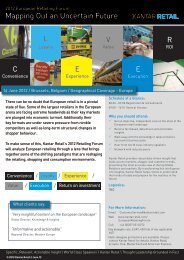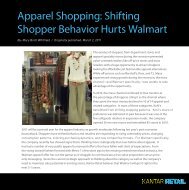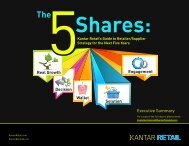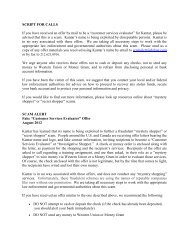The Future Shopper March 2013.pdf - Kantar Retail
The Future Shopper March 2013.pdf - Kantar Retail
The Future Shopper March 2013.pdf - Kantar Retail
You also want an ePaper? Increase the reach of your titles
YUMPU automatically turns print PDFs into web optimized ePapers that Google loves.
<strong>The</strong> see-through<br />
product<br />
<strong>The</strong> German Android<br />
app Barcoo combines<br />
QR scanning and GPS<br />
technology to direct<br />
shoppers to providers<br />
that are the cheapest<br />
and closest to them. It<br />
also provides information<br />
on the eco-footprints<br />
of companies and<br />
‘nutritional traffic lights.’<br />
Everything you need to<br />
know about a product is<br />
now available to you—on<br />
the device in your hand.<br />
that this gives them time to<br />
respond while the digitaldependent<br />
generation comes<br />
of age, they should think again.<br />
As digital technology has<br />
matured over the past two<br />
decades, younger, leadingedge<br />
users have invariably<br />
educated older users about<br />
the possibilities of new<br />
applications, such that usage<br />
has boomed among older<br />
generations. We saw this with<br />
texting a decade ago. Now<br />
we’re seeing something similar<br />
with video-calling services<br />
such as Skype or Apple<br />
FaceTime.<br />
SoLoMo<br />
<strong>The</strong> second trend is the<br />
interaction between<br />
smartphones, typically carried<br />
by purposeful users, and dumb<br />
location-based information,<br />
embedded in objects through<br />
sensors.<br />
SoLoMo is an ugly, if catchy,<br />
acronym; it stands for the<br />
forms of exchange, media and<br />
commerce that are enabled<br />
by the growth in personal<br />
portable platforms: Social,<br />
Locational and Mobile. <strong>The</strong><br />
phone enables all three in<br />
combination. Social media<br />
applications become placespecific<br />
when operated on<br />
mobile devices, while social<br />
media is rapidly turning into<br />
‘social commerce’ (see panel).<br />
Going to<br />
market is<br />
a human<br />
behavior that<br />
dates back<br />
10,000 years<br />
Smartphone-enhanced<br />
shopping is becoming<br />
standard. Two-thirds of<br />
smartphone owners in the<br />
U.S. say they use them while<br />
shopping in grocery stores;<br />
nine percent say they use<br />
them to download and redeem<br />
coupons. 8<br />
But ‘locational’ is the most<br />
transformative of these three<br />
elements. Most consumers say<br />
they’re willing to allow their<br />
phone to share their location<br />
in exchange for perks, such as<br />
mobile coupons or free use of<br />
apps. One-tenth of American<br />
cellphone owners use mobile<br />
location services at least<br />
weekly. 9 <strong>The</strong> venture capitalist<br />
and tech analyst, Bill Gurley,<br />
suggests there is significant<br />
growth to come here,<br />
especially in local markets,<br />
enabled by services such<br />
as the U.S.-based Yelp and<br />
vertical service providers such<br />
as OpenTable or AirBnB. Only<br />
12 percent of U.S. restaurant<br />
© 2013 <strong>The</strong> <strong>Future</strong>s Company/<strong>Kantar</strong> <strong>Retail</strong>. Some rights reserved. 7












